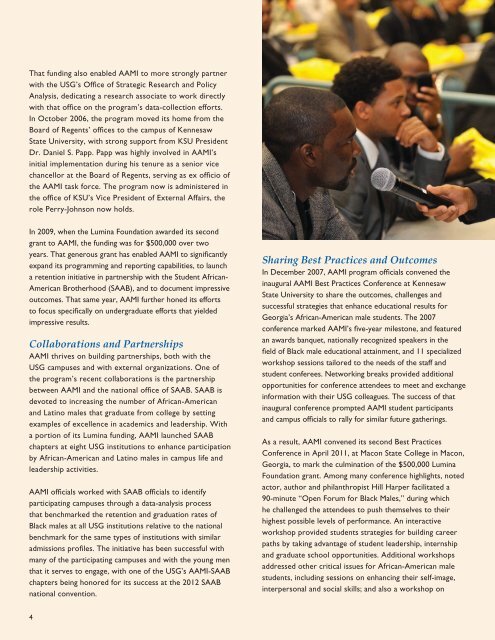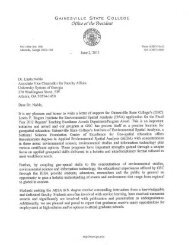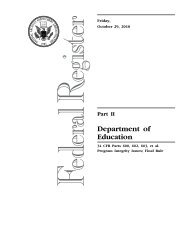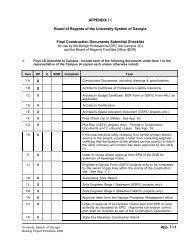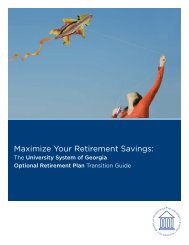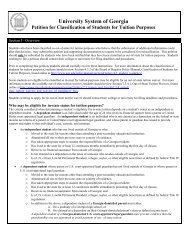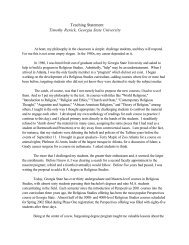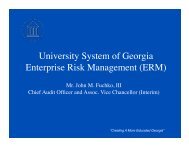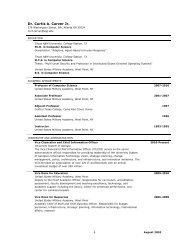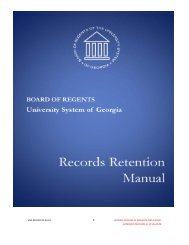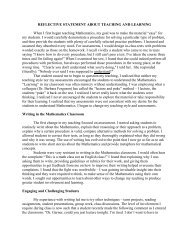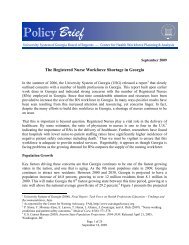Recruiting, Retaining and Graduating Black Male College Students
Recruiting, Retaining and Graduating Black Male College Students
Recruiting, Retaining and Graduating Black Male College Students
- No tags were found...
You also want an ePaper? Increase the reach of your titles
YUMPU automatically turns print PDFs into web optimized ePapers that Google loves.
That funding also enabled AAMI to more strongly partnerwith the USG’s Office of Strategic Research <strong>and</strong> PolicyAnalysis, dedicating a research associate to work directlywith that office on the program’s data-collection efforts.In October 2006, the program moved its home from theBoard of Regents’ offices to the campus of KennesawState University, with strong support from KSU PresidentDr. Daniel S. Papp. Papp was highly involved in AAMI’sinitial implementation during his tenure as a senior vicechancellor at the Board of Regents, serving as ex officio ofthe AAMI task force. The program now is administered inthe office of KSU’s Vice President of External Affairs, therole Perry-Johnson now holds.In 2009, when the Lumina Foundation awarded its secondgrant to AAMI, the funding was for $500,000 over twoyears. That generous grant has enabled AAMI to significantlyexp<strong>and</strong> its programming <strong>and</strong> reporting capabilities, to launcha retention initiative in partnership with the Student African-American Brotherhood (SAAB), <strong>and</strong> to document impressiveoutcomes. That same year, AAMI further honed its effortsto focus specifically on undergraduate efforts that yieldedimpressive results.Collaborations <strong>and</strong> PartnershipsAAMI thrives on building partnerships, both with theUSG campuses <strong>and</strong> with external organizations. One ofthe program’s recent collaborations is the partnershipbetween AAMI <strong>and</strong> the national office of SAAB. SAAB isdevoted to increasing the number of African-American<strong>and</strong> Latino males that graduate from college by settingexamples of excellence in academics <strong>and</strong> leadership. Witha portion of its Lumina funding, AAMI launched SAABchapters at eight USG institutions to enhance participationby African-American <strong>and</strong> Latino males in campus life <strong>and</strong>leadership activities.AAMI officials worked with SAAB officials to identifyparticipating campuses through a data-analysis processthat benchmarked the retention <strong>and</strong> graduation rates of<strong>Black</strong> males at all USG institutions relative to the nationalbenchmark for the same types of institutions with similaradmissions profiles. The initiative has been successful withmany of the participating campuses <strong>and</strong> with the young menthat it serves to engage, with one of the USG’s AAMI-SAABchapters being honored for its success at the 2012 SAABnational convention.Sharing Best Practices <strong>and</strong> OutcomesIn December 2007, AAMI program officials convened theinaugural AAMI Best Practices Conference at KennesawState University to share the outcomes, challenges <strong>and</strong>successful strategies that enhance educational results forGeorgia’s African-American male students. The 2007conference marked AAMI’s five-year milestone, <strong>and</strong> featuredan awards banquet, nationally recognized speakers in thefield of <strong>Black</strong> male educational attainment, <strong>and</strong> 11 specializedworkshop sessions tailored to the needs of the staff <strong>and</strong>student conferees. Networking breaks provided additionalopportunities for conference attendees to meet <strong>and</strong> exchangeinformation with their USG colleagues. The success of thatinaugural conference prompted AAMI student participants<strong>and</strong> campus officials to rally for similar future gatherings.As a result, AAMI convened its second Best PracticesConference in April 2011, at Macon State <strong>College</strong> in Macon,Georgia, to mark the culmination of the $500,000 LuminaFoundation grant. Among many conference highlights, notedactor, author <strong>and</strong> philanthropist Hill Harper facilitated a90-minute “Open Forum for <strong>Black</strong> <strong>Male</strong>s,” during whichhe challenged the attendees to push themselves to theirhighest possible levels of performance. An interactiveworkshop provided students strategies for building careerpaths by taking advantage of student leadership, internship<strong>and</strong> graduate school opportunities. Additional workshopsaddressed other critical issues for African-American malestudents, including sessions on enhancing their self-image,interpersonal <strong>and</strong> social skills; <strong>and</strong> also a workshop onbalancing athletics <strong>and</strong> academics. AAMI program officialsalso engaged in insightful discussions about creating <strong>and</strong>sustaining successful campus programs.In September 2012, AAMI convened its third conference, inpartnership with the National <strong>Black</strong> <strong>College</strong> Alumni Hall of FameFoundation, Inc. The conference marked the historic 10-yearanniversary of AAMI’s launching back in September 2002 —providing the organization’s officials <strong>and</strong> participating campusprograms an opportunity to reflect on the pioneering initiative’simpact, challenges <strong>and</strong> future strategic directions. The three-daygathering, held in Atlanta, attracted nearly 300 African-Americanmale students, AAMI program directors, <strong>and</strong> key stakeholdersof the statewide initiative. Conferees were afforded manyopportunities to share experiences <strong>and</strong> concerns, learn newskills, <strong>and</strong> hear unique perspectives on a wide range of topicsrelated to <strong>Black</strong> males’ academic success. Participants heard fromoutst<strong>and</strong>ing keynote speakers from business, higher education,sports <strong>and</strong> entertainment that emphasized the value of academicachievement in their careers <strong>and</strong> personal lives. The conveningalso again featured an Awards <strong>and</strong> Recognition Banquet, wherebest-practice contributors <strong>and</strong> key advocates of the AAMIprogram were recognized.“The University System of Georgia has done pioneering workin identifying <strong>and</strong> addressing the educational challenges facedby black males, <strong>and</strong> our work is frequently benchmarked,”Perry-Johnson said. “We convene these conferences to sharethe vital information we have learned with our USG colleagues<strong>and</strong> with others engaged in this important work. Our goal is todemonstrate what works, so that others may replicate, exp<strong>and</strong><strong>and</strong> — most importantly — fund these important programs.”A National ModelAAAMI has garnered significant national attention. Theprogram is widely credited with being the first-ever statewideeffort specifically focused on increasing post-secondaryeducational attainment among <strong>Black</strong> males. Peers in thehigher education community have sought to learn from <strong>and</strong>adopt AAMI’s trailblazing model as awareness has increasednationally of the ethnic <strong>and</strong> gender disparities prevalent onU.S. college campuses. Program officials have respondedto scores of benchmarking <strong>and</strong> research requests, hostedvisits from numerous higher education <strong>and</strong> organizationalentities, made presentations at national conferences <strong>and</strong> beenfeatured in numerous state <strong>and</strong> national media outlets. Theprogram positions the University System of Georgia’s work inimproving educational outcomes for <strong>Black</strong> males as a nationalmodel <strong>and</strong> as a potential demonstration project.Program AssessmentOver the past decade, AAMI has matured <strong>and</strong> reached a pivotaldevelopmental point. At this juncture, the need to conduct anassessment of the program’s groundbreaking work since itsinception is vital. To aid with the review effort, during fiscalyear 2012 AAMI program officials contracted a consultantto undertake a pre-evaluation assessment aimed at formallydocumenting AAMI’s program theory <strong>and</strong> logic model. Theconsultant’s report — based on visits to 12 campuses engagedin the AAMI project, interviews with more than 50 AAMIstakeholders <strong>and</strong> participants, <strong>and</strong> an exhaustive review ofAAMI program reports, data <strong>and</strong> literature — establishes a firmfoundation for a future independent program evaluation. Fundingsupport is being sought for this endeavor.While AAMI’s targeted recruitment <strong>and</strong> retention programshave produced heartening results, the USG’s statewide initiativemust continue tackling the dearth of <strong>Black</strong> male collegegraduates <strong>and</strong> their disproportionate status relative to their male<strong>and</strong> female peers. In particular, AAMI must address the clearretention challenges that have developed with the increasingenrollment of <strong>Black</strong> male students. What is abundantly clearto AAMI <strong>and</strong> USG officials is that the educational plight ofAfrican-American males can be reversed with the commitmentof appropriate resources. Doing so has become an economicimperative for our nation, <strong>and</strong> we look forward to continuingour partnerships with those who share this mission.4 5


